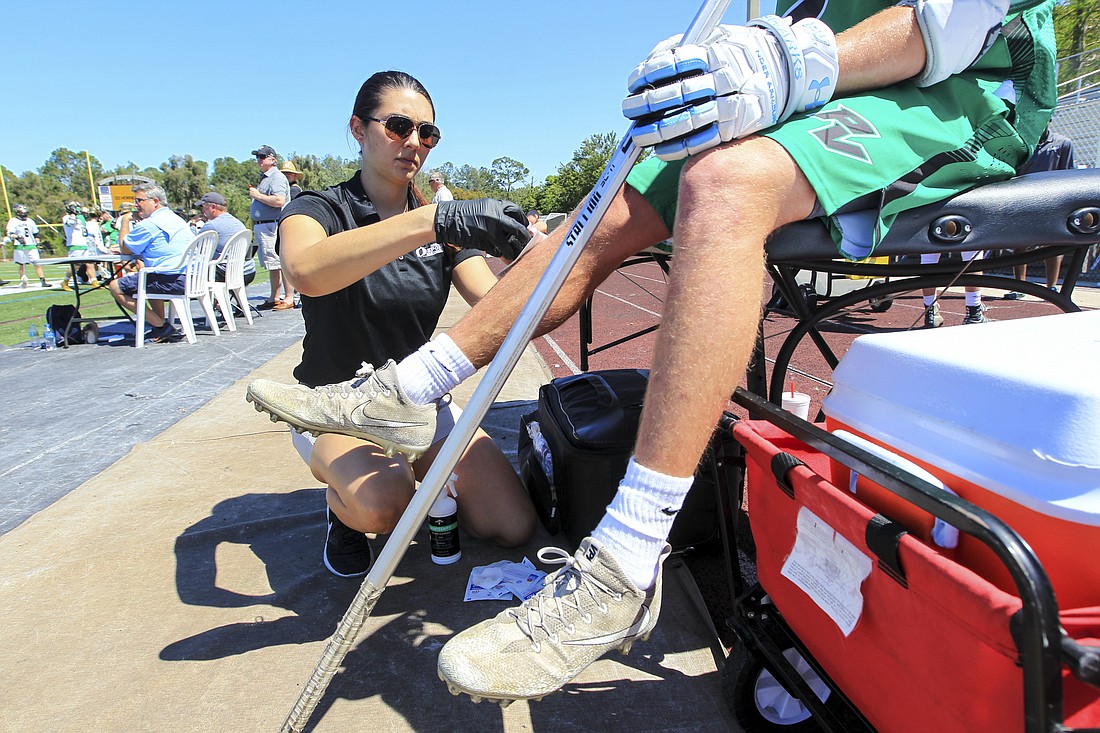- April 4, 2025
-
-
Loading

Loading

You might not know their names, and you might not know their faces, but there is one thing that’s certain — you’re glad they’re there.
While there are many actors that take part behind the scenes at sporting events, none might be bigger than athletic trainers — the first responders of the sports world.
When an athlete suffers a vicious blow or lands awkwardly, they’re the first ones out onto the field to lend a hand.
For parents, coaches and the players themselves, they are seen as proverbial lifesavers. That’s why trainers like Gabriella Armor and Ronaldo Green take their jobs as seriously as they do.
That kind of seriousness is needed when dealing with a job that’s as time consuming as many medical jobs.
“We’re the first ones there and the last ones to leave with everything,” Armor said. “We set up and make sure that we get there in enough time for the athletes to get treatment; get taped up or whatever they need to do.”
“It’s not as time consuming as the college level, but there are times where a coach will call a 5 a.m. practice on a Monday morning, on the day before (a game),” Green said.
Both Armor and Green work at Orlando Sports Medicine but are contracted as athletic trainers by Bishop Moore Catholic High School. The job requires them to split their time between the clinic and the school.
As a former high school basketball player who tore her ACL twice, Armor found a passion for sports medicine during her physical therapy — though she originally didn’t know much about the field.
That all changed during a health class when she was at the University of Central Florida. From there, she fell in love with the ability to be around athletes and help them the way her physical therapists had helped her.
“You get that one-on-one care with the athlete, and you get to follow them from before they’re injured to return to play, so it’s a great personal connection with that athlete,” Armor said. “And it’s very hands on, we’re always busy (and) always doing something.”
Green’s story is fairly similar to Armor’s, though as a basketball player in high school, he never suffered any serious injuries.
As a huge sports fan, Green spent a lot of time hanging out with the athletes and trainers at the small college he attended — which inspired him to get his masters in athletic training from Stephen F. Austin University.
“I’ve always been around sports, and when you’re not playing anymore, you can be an athletic trainer and offer the medical attention that the kids need,” Green said. “And athletes always have fun personalities … so it’s kind of a joy to be around.”
While the job of athletic trainer sounds pretty self-explanatory, Green and Armor said a lot of people don’t understand their actual role on and off the field.
Sometimes, they said, people think all they do is apply ice or tape ankles, but the job can be a lot more serious than that.
Before Green joined on with Orlando Sports Medicine, he helped save an athlete’s life while working at ESPN’s Wide World of Sports.
Toward the end of a late-night basketball game, Green, who was an intern at the time, was forced into action when a player went down on the court.
“I grab the AED (automated external defibrillator) and run over and get there, and we start the CPR cycle, calling people that we need to call to activate EMS,” Green said. “His heart was stopped — he had a condition — so we got the AED on him, and it was able to administer shocks to bring him back before the EMS got there.”
And their jobs as athletic trainers don’t just stop with the physical injuries they deal with — they’re also counselors, in a way.
While an injury can physically slow you down, it can also be a blow to a person’s mental state, especially to high school kids.
“You really have to develop a sense of trust with the athlete, because you’re taking full medical care of them,” Armor said. “You have to be able tell when they’re over-exaggerating or if they’re in a state of anxiety and depression.”
“At this level if they get injured — and say it is a significant injury — for a lot of them it is the first type of adversity they’ve had to deal with in their life,” Green said. “We’re not that old, but being older than high school kids, we have a little more perspective to offer.”